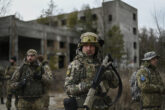November 22, 2016
Phases of War and the Iraq Experience
Applying the phasing construct to a quarter-century of U.S. military involvement in Iraq
The difficulties of applying the U.S. military’s phasing construct to the realities of conflict are rarely more evident than when examining the American experience in Iraq. Though U.S. involvement in Iraq has traditionally been divided into two distinct periods of conflict, the 1990–1991 Gulf War and the 2003–2011 Iraq War, the reality is that the U.S. military has been nearly continuously engaged in Iraq for the past 26 years. The United States has conducted special operations raids into, launched cruise missiles at, imposed no-fly zones over, and outright invaded Iraq. The United States also provided humanitarian aid, financially supported local actors, and even governed the country. The six-phase planning construct does a poor job of accurately representing the range of activities over a quarter-century of U.S. foreign policy and military strategy in Iraq.
The phasing construct is optimized for traditional conflict, and the continuous conflict in Iraq has been anything but. Operation Desert Storm is straightforward: Phase II (Seize Initiative) closely followed by Phase III (Dominate). The same was the case for the opening days of Operation Iraqi Freedom, when the United States toppled Saddam’s regime in just 21 days. Unsurprisingly, a phasing construct conceptually designed for sharp periods of conventional state-on-state conflict easily mapped onto those scenarios. It is much more difficult, however, to categorize other periods of the Iraq experience.
Read the full article at War on the Rocks
More from CNAS
-
Defense / Transatlantic Security
When Defense Becomes Destruction: Austria-Hungary’s Mistake and Ukraine’s RiskThis article was originally posted on War on the Rocks. The southeastern Polish city of Przemyśl, with its elegant 19th century Habsburg-era train station, remains one of the ...
By Franz-Stefan Gady
-
Defense / Transatlantic Security
Ukraine’s Catch-22 MomentThis article was originally published in the Financial Times. In Joseph Heller’s wartime classic, Catch-22, the protagonist Yossarian seeks out the US army surgeon Doc Daneeka...
By Franz-Stefan Gady
-
CNAS Insights | Budgetary Own Goals Undermine “Speed and Volume”
On November 7, Secretary of Defense Pete Hegseth laid out a plan to overhaul the Department of Defense’s (DOD’s) acquisition system. Placing an emphasis on delivering new capa...
By Philip Sheers, Carlton Haelig & Stacie Pettyjohn
-
Drones: Who Is Making the New Weapons of War?
From Ukraine and Russia to Gaza and Sudan, drones have become a key weapon of war. Which companies are making them, and profiting from this rapidly expanding but controversial...
By Stacie Pettyjohn




